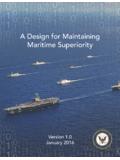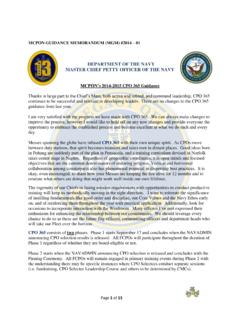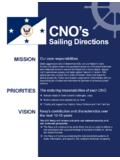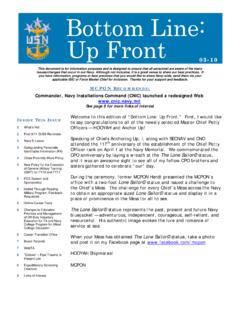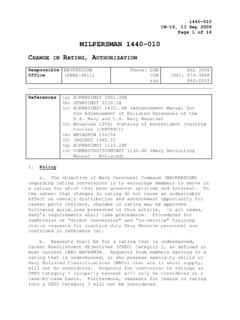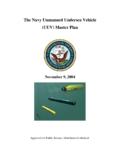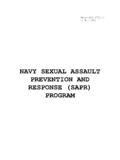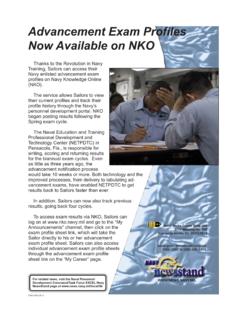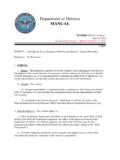Transcription of OFFICE OF THE SECRETARY WASHINGTON DC …
1 DEPARTMENT OF THE NAVY. OFFICE OF THE SECRETARY . 1000 NAVY PENTAGON. WASHINGTON DC 20350 1000. SECNAVINST 3070 . 2. DUSN (P). 5 May 16. SECNAV INSTRUCTION From : SECRETARY of the Navy Subj : OPERATIONS SECURITY. Ref: See enclosure (1). Encl : (1) References (2) Definitions (3) Department of the Navy Critical Information List (4) Roles and Responsibilities (5) Oversight (6) Operations Security: Detailed Self-Inspection Tool 1. Purpose. Establishes policy , procedures , and responsibilities for the Department of the Navy (DON) Operations Security (OPSEC) program per references (a) and (b) . 2. Definitions . See enclosure (2) . 3. Applicability . Applies to Total Force personnel, employed by, detailed or assigned to the DON , including Government Civilians (Appropriated and Non-Appropriated Funds) , members of the active and reserve components of the Navy (USN) and U. S. Marine Corps (USMC) ; an expert or consultant performing services for the DON through a personnel appointment or a contractual arrangement and industrial or commercial contractor , licensee, certificate holder , or grantee , including subcontractors.
2 4. Policy a. Pursuant to reference (a) , the Secretariat , USN , and USMC shall maintain effective OPSEC programs that ensure coordination between public affairs, cybersecurity , security , operations , acquisition , intelligence , training , and command authorities and include mechanisms for enforcement , accountability , threat awareness , and the highest level of leadership oversight. OPSEC protects critical information to prevent an adversary from determining friendly intentions or SECNAVINST 5 May 16. capabilities. Programs must endeavor to establish a proper balance between dissemination of information to families and the public, consistent with the requirement to protect critical information and maintain essential secrecy. b. Commanders shall take all OPSEC measures required to prevent disclosure of critical information and protect essential secrets. c. Commanders are required to establish, resource, and maintain effective OPSEC programs.
3 A program consists of policies, manning, training, and equipping functions necessary for OPSEC planning and execution, and to ensure all personnel understand their responsibilities to protect essential secrecy. The maintenance and effectiveness of an OPSEC program is the responsibility of each Commanding Officer. Each program shall include, at a minimum: a designated OPSEC program manager and local instruction (policy and/or procedures specifically including requirements for oversight of subordinates); an effective OPSEC Working Group; a critical information list (CIL); training and awareness; family outreach; email, web, social media, and public affairs policies and strategies; as well as contract and acquisition review procedures. It shall also include processes to report and mitigate disclosures of critical information and potential disciplinary action against those who violate OPSEC policies. For operational Commands, the program shall also include measures and plans required to manage signatures of sensitive missions, programs, and/or operations.
4 D. Commanders are solely responsible for their OPSEC. program(s). Management of the program can be delegated to officers O-3 or above or civilians GS-12 or higher, at a minimum, with sufficient authority and staff to manage the program for the Command. They must successfully complete OPSEC. practitioner qualification training, and shall serve in the position for a minimum of 18 months. As a critical position, it must be filled at all times by a properly trained individual. OPSEC is an operations function, and therefore responsibilities should reside within the operations department. For Commands without an operations department, OPSEC program manager responsibilities shall be assigned to individuals who have significant authority in command operations. The OPSEC program manager shall have unimpeded access to the Commanding Officer. 2. SECNAVINST 5 May 16. This individual and the Commanding Officer shall ensure OPSEC is incorporated into all operations and activities.
5 Due to the level of oversight over subordinate units and/or the sensitivity of the mission, Echelon I, II, and USMC Two-Star Commands and higher, require a full-time OPSEC program manager, unless waived per enclosure (4), paragraph 10b. e. Program managers must be citizens and have a favorably adjudicated Single Scope Background Investigation completed within 5 years prior to assignment. Below Echelon II. or USMC Two-Star Command equivalent, as well as for all OPSEC. coordinators, a SECRET clearance is sufficient. f. OPSEC is an operations function, and shall be integrated into all operational planning and coordinated with relevant military deception and other information operations programs. g. OPSEC shall be coordinated and integrated into all other security disciplines (personnel, information, cybersecurity, acquisition, industrial, and physical, including law enforcement and antiterrorism/force protection). h. DON organizations shall provide approved OPSEC training, including social media awareness, controlled unclassified information, and security review for public release pursuant to references (b) through (h), to all organization personnel upon accession.
6 All DON personnel must also complete approved OPSEC. awareness training on an annual basis and prior to receiving approval for access to DON networks. All training must be formally documented, maintained, and available on-line for higher Command review. i. All Commanding Officers are responsible for oversight, guidance, and supervision over subordinate elements. Oversight and policy authority follow the administrative chain of command except if the organization is a deployable unit where it should follow the operational chain of command. j. Decisions regarding release of information into the public domain shall include a review by an appropriately designated and trained OPSEC professional. Illustrative examples of such information include information released to Congress, budget documents, press releases, speeches, 3. SECNAVINST 5 May 16. newsletters, and official posts to web based resources pursuant to references (g) through (k).
7 All public affairs professionals must be properly trained per references (a) and (b), and understand their command's CIL and at what level of detail its contents may be discussed. k. Per reference (h), Public Affairs is responsible for the oversight and management of all content on official DON. publicly-accessible Web presences. OPSEC, security, information security, and public affairs professionals are required to maintain on-going collaboration to ensure OPSEC is maintained on command social media profiles. l. Research, development, test, and evaluation (RDT&E). activities as defined in references (i) and (j) are particularly vulnerable to compromise, both classified and controlled unclassified, and as such have an inherent requirement to implement OPSEC. Supply Chain Risk Management and Critical Program Information (CPI) protection principles must be adhered to per references (j) and (k), including OPSEC countermeasures.
8 M. OPSEC shall be used to evaluate the vulnerabilities of sensitive information and technology during all RDT&E activities and phases. Program managers at all levels should coordinate with their Acquisition Security/Research and Technology Protection Leads throughout the RDT&E life-cycle, especially regarding release of information into the public domain, prior to sensitive testing, and aboard or with operational units. n. DON program executive officers, program, project, or product managers, and contracting officials shall include OPSEC. as a stipulation in all contracts. All requirements packages must receive an OPSEC review at the start and completion of the contracting process to identify critical and/or sensitive information by the requiring activity OPSEC officer. o. The DON CIL (enclosure 3) shall inform Command CILs, as well as enhance OPSEC guidance provided in public affairs policy (reference (h)). All Commands are responsible for developing their own unique CIL based upon threat information specific to their organization.
9 Inclusion in the CIL in and of itself does not classify the information or preclude the information from public release. The Public Affairs Officer (PAO) and OPSEC. 4. SECNAVINST 5 May 16. practitioner shall work with Command leadership to determine what level of detail to release publicly when the need for transparency outweighs the risk of disclosure. p . Command critical information shall be transmitted in a manner that reduces the risk of aggregation and compromise. Where practicable, Secret Internet Protocol Router Network (SIPR) is the default method of transmission for critical information. When SIPR is not available, and the information is deemed by the Commander to be unclassified and not sensitive to o n - going or planned operations, then encrypted unclassified transmission is authorized with the provision that OPSEC program is sufficiently robust and appropriate level of network monitoring is in place. q. The Director of the Naval OPSEC Support Team (NOST).
10 Serves as a Senior Advisor to both Deputy Under SECRETARY of the Navy (Policy) (DUSN (P)) and Chief of Naval Operations (CNO) on all issues regarding OPSEC, safe use of social media, security review fo r publ i c release, and related training. 5. Responsibilities . See enclosure (4). 6. Oversight. See enclosure (5). 7. Self-Inspections. Self - inspections may be f a ci litated us i ng enclosure ( 6) . 8. Records Management. Records cre a ted as a result of this instruction, regardless of media and format, shall be managed per SECNAV Manual of January 2012 . 9. Forms and Re ports. The r e porting requirements contained in enclosure (4), paragraphs 3g, Ba, 9b, lOd, and the Annual OPS EC. Report are assigned to Departme nt of Defense (DoD) Report Control Symbol DD-INT(A)2228(3070). "-h,~o<-'3--- JANINE A . DAVIDSON. Acting 5. SECNAVINST 5 May 16. Distribution: Electronic only, via Department of the Navy Issuances Web site 6. SECNAVINST 5 May 16.
